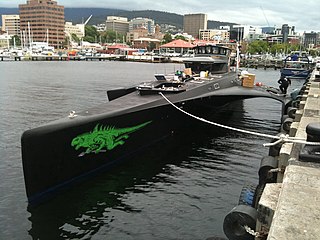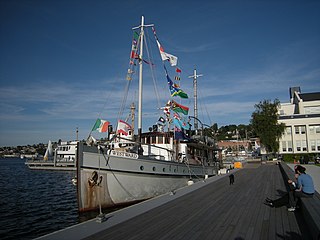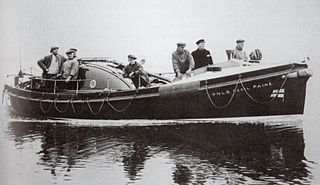
A motorboat, speedboat or powerboat is a boat that is exclusively powered by an engine.

A motor torpedo boat is a fast torpedo boat, especially of the mid 20th century. The motor in the designation originally referred to their use of petrol engines, typically marinised aircraft engines or their derivatives, which distinguished them from other naval craft of the era, including other torpedo boats, that used steam turbines or reciprocating steam engines. Later, diesel-powered torpedo boats appeared, in turn or retroactively referred to as "motor torpedo boats" for their internal combustion engines, as distinct from steam powered reciprocating or turbine propulsion.

The world unlimited Water Speed Record is the officially recognised fastest speed achieved by a water-borne vehicle, irrespective of propulsion method. The current unlimited record is 511.11 km/h (317.59 mph), achieved by Australian Ken Warby in the Spirit of Australia in 1978.
The Aberdonia is a British pre-war motor yacht moored at Chelsea Harbour. Built by the Thornycroft ship yard and launched in 1935 Aberdonia has a rich history, former uses include a patrol boat, mine sweeper and is one of the Little ships of Dunkirk.
The Defoe Shipbuilding Company was a small ship builder established in 1905 in Bay City, Michigan, United States. It ceased to operate in 1976 after failing to renew its contracts with the United States Navy. The site of the former company is now being developed for business and housing on the bank of the Saginaw River.

MV Brigitte Bardot is a unique high-tech 35 m (115 ft) stabilized monohull twin diesel engine powered vessel designed by Nigel Irens. Construction of the vessel began in June 1997 and she was launched on 16 March 1998. The official naming ceremony took place on 3 April 1998 in London's West India Dock. In 2021, the vessel was sold to a private owner.

Blue Bird K4 was a powerboat commissioned in 1939 by Sir Malcolm Campbell, to rival the Americans' efforts in the fight for the world water speed record.

During the First World War, following a suggestion from three junior officers of the Harwich destroyer force that small motor boats carrying a torpedo might be capable of travelling over the protective minefields and attacking ships of the Imperial German Navy at anchor in their bases, the Admiralty gave tentative approval to the idea and, in the summer of 1915, produced a Staff Requirement requesting designs for a Coastal Motor Boat for service in the North Sea.
The Little Ships of Dunkirk were about 850 private boats that sailed from Ramsgate in England to Dunkirk in northern France between 26 May and 4 June 1940 as part of Operation Dynamo, helping to rescue more than 336,000 British, French, and other Allied soldiers who were trapped on the beaches at Dunkirk during the Second World War.

USS Artemis (SP-593), launched as the steam yacht Cristina then upon sale the yacht was renamed Artemis. The yacht was purchased by the United States Navy during World War I and the name was retained. Artemis was armed with guns and depth charges and sent to Europe as a patrol craft to protect Allied ships from German submarines and other dangers. The patrol yacht was renamed Arcturus in 1918. Post-war she was returned to the United States and turned over to the United States Coast and Geodetic Survey. Later, again Artemis, the vessel was in civilian operation until burning and sinking in 1927.

MV Westward is an 86-foot (26 m) motor yacht, "arguably Seattle’s most famous motor yacht," originally constructed in 1924 by Ted Geary for inventor Campbell Church, Sr., and currently owned by Bill Bailey. Her home port is Friday Harbor, Washington and she is listed on the U.S. National Register of Historic Places.

Sundowner is a motor yacht formerly owned by Charles Lightoller, the second officer of RMS Titanic and the most senior officer to survive her sinking in 1912.

RML 497 is a former Royal Navy Fairmile B motor launch from World War II. She was named Western Lady III on her entry to civilian service, as a passenger motor vessel for Western Lady Ferry Service. From 2009 to 2015, she operated as The Fairmile for Greenway Ferry on their day cruise route from Torquay and Brixham to Dartmouth and Greenway. In May 2013, she was returned to her original wartime appearance. Torbay's "ferry wars" forced her removal from service, and in December 2015, RML 497 was acquired by the National Museum of the Royal Navy.
The motor yacht Titanic is a 1,900-tonne yacht that was formerly the Japanese Government's research/fishing vessel Toko Maru and later Kelso. In March 2010, she developed a leak while sailing in the Caribbean. Her rescue by the United States Coast Guard was co-ordinated from the United Kingdom.

Amazon is a 102-foot (31 m) long screw schooner ex-steam yacht built in 1885 at the private Arrow Yard of Tankerville Chamberlayne in Southampton.

Rosinco was a diesel-powered luxury yacht that sank in Lake Michigan off the coast of Kenosha, Wisconsin in 1928. The yacht was built in 1916 as Georgiana III and served during World War I as USS Georgiana III, a Section patrol craft, under a free lease to the Navy by her owner and commanding officer. After the war the yacht was sold and renamed Whitemarsh in 1918. In 1925, after sale to Robert Hosmer Morse of Fairbanks-Morse, the yacht became Rosinco. She was sunk following a collision in 1928 and the wreck was added to the National Register of Historic Places in 2001.

RNLB Cecil Paine is a retired Liverpool-class non-self-righting lifeboat of the Royal National Lifeboat Institution. It was the second motor lifeboat to be stationed in the English coastal town of Wells-next-the-Sea in the county of Norfolk in the United Kingdom, and was on station at Wells from 25 July 1945 until she was sold in June 1965.

RNLB Lucy Lavers was an RNLI lifeboat which was on No. 2 station at Aldeburgh from 1940 until 1959 when she was placed in the reserve fleet until 1968 when she was retired. The Rescue Wooden Boats Charity is currently undertaking restoration of the vessel. The Lucy Lavers is entered in the National Historic Ships register and has the Certificate No 2206.
Williams and Parkinson of Deganwy quay were traditional boat builders in North Wales established by Cyril Williams in 1930, later on becoming Williams and Nixon following the Second World War and continuing to build until 1979.

The Coquette was a 19th-century yacht and pilot boat, built in 1845 by Louis Winde, at the Winde & Clinkard shipyard in Chelsea, Massachusetts for yachtsmen James A. Perkins. Her design was based on a model by shipbuilder Dennison J. Lawlor. The Coquette was a good example of an early American yacht with a clipper bow. As a yacht, she won the attention for outsailing the larger New York yacht Maria at the second New York Yacht Club regatta in 1846. Perkins sold the Coquette to the Boston Pilots' Association for pilot service in 1848. She continued as a pilot boat until 1867 when she was sold as a Blackbirder to be used on the African coast.














